mobile View, to the German Version tap the flag


- historical region in Spain
- 10th to 13th century Kingdom of Castile
- 13th to 19th century part of the Kingdom of Castile-León
- today part of the Autonomous Region of Castile-León
- own name:
– Spanish: Castilla
• Flags
• Meaning/Origin of the Flag
• Coat of Arms
• Meaning/Origin of the Coat of Arms
• Map of the historical Kingdoms on the Iberian Peninsula
• Numbers and Facts
• History
• Origin of the Country's Name
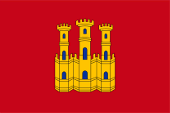
12th to 13th century,
Flag of Castile,
Source, by: Wikipedia (ES)



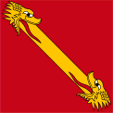
14th to 16th century,
La banda real de Castilla,
temporarily flag of the Castilian kingship,
Source, by: Wikipedia (ES)



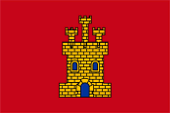
Flag of local nationalists,
Source, by: Wikipedia (ES)



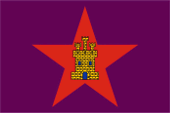
Flag of leftist local nationalists,
Source, by: Wikipedia (ES)



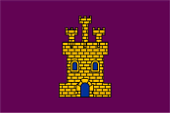
Flag of leftist local nationalists,
Source, by: Wikipedia (ES)




The flag of the ancient kingdom of Castile was, as was customary at the time, a heraldic flag. That is a flag that showed the image of the coat of arms of the country (actually the ruler). Consequently, the flag bunting is solid red with the image of a golden castle in the center. In this early period of flags, they were actually not shaped like our flags today either. The flags were more like coats of arms, which were attached to the mast with the straight side. From the 14th to the 16th century, some kings of Castile (even when the Castilian Crown was already connected to León) used a red flag with two dragon heads connected by a golden diagonal bar, the Banda real de Castilla, a banner probably going back to a red flag with a golden diagonal bar. Very many kings also had their own personal banners, always red, often with representations of saints or crosses. Political and cultural groups that today want to preserve and promote the identity of Castile, or even desire the independence of the country, use nowadays often the plain crimson flag with the (often stylized) castle, sometimes supplemented by a lion. In the case of politically left-wing groups, the flags are morado/purple and or show additionally a red star in the center.
Source:
Wikipedia (ES),
Flags of the World,
Volker Preuß

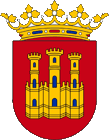
Coat of arms of Castile,
Source, by: Wikipedia (ES)

The coat of arms of the ancient Kingdom of Castile is a plain red shield with a golden castle in the middle and was first described in 1165. It is a talking coat of arms because the coat of arms provides a direct reference to the name of the country. There are many different depictions of the castle circulating, sometimes detailed, sometimes stylized, sometimes with a gate, sometimes without. However, one common feature is always three towers.
Source: Wikipedia (EN),
Volker Preuß

Map of the historical Kingdoms on the Iberian Peninsula (ca. 1220):
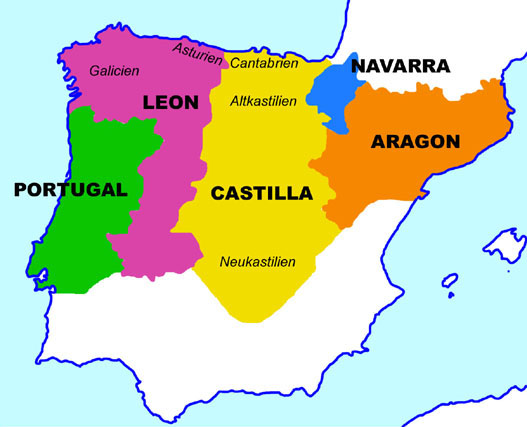
Map: Volker Preuß

Area:
in times of largest expansion, ca. 31.000 square miles
Inhabitants:
in the middle ages Castilians, as well as descendants of other Iberians, but even descendants of the Western Goth
Capital:
Burgos, since 1085 Toledo
official Language:
Castilan (Spanish)
Source: Wikipedia (ES)

The history of Castile starts in principle with the Kingdom of Asturia/León. But in reality Castile came into being not until the secession from that kingdom in the year 925.
early age · settlement of Iberians (Cantabrians)
ca. 600 v.Chr. · immigration of Celts, mix with the Iberians, evolution of the Celtiberians
200 v. Chr. · Second Punic War, the Roman Empire acquires the possessions of Carthago in Iberia, subjugation of whole Iberia until the year 19 B.C., Roman settlement, romanization, the today’s Castile comes to the Roman province of Hispania Tarraconensis
ca. 400 · Great Transmigration (Migration Period), immigration of Alans, Suebs and Western Goth, the today’s Castile becomes a part of the Empire of the Western Goth
711–714 · annihilation of the Empire of the Western Goth by from northern Africa coming Arabs, the Western Goth retreat to Asturia and Cantabria, the south of the today's Old Castile becomes occupied by the Arabs, the north (Bardulia) remains unoccupied and belongs to the Kingdom of Asturia-León and is administered by counts, plant of numerous castles (castles → Castile)
925 · Count Fernan Gonzalez of Burgos, the Count of Castile separates from Asturia-León, armed (unsuccessful) campaigns of his sons and grandsons against Asturia-León
1026 · murder of Count Garcia of Castile, the heritage comes to his brother-in-law, King Sancho the Elder (Sancho III.) of Navarra
1037 · death of King Sancho III. of Navarra, Castile comes as heritage to his son Ferdinand, Bermudo III. of León trys to win back Castile for his empire from the Navarra dynasty, but he falls in the battle near Carrion River, vanish of the Pelayo dynasty of León, the Kingdom of León inherits King Ferdinand of Castile, Castile and León become united under one crown
1040–1065 · persistant liberation fights against the Arabs, in this way gain of areas in southern direction
1054 · Battle of Atapuerta, abortive attack of King Garcia of Navarra (brother of King Ferdinand)
1067 · death of King Ferdinand of Castile, heritage division of the empire under his sons (Sancho II. gets Castile, Alfons gets León and Asturia, Garcia gets Galicia), but Sancho II. banishes his brethren and rules over the whole empire of his father
1072 · King Sancho II. becomes murdered, his brother Alfons VI. the lawful king of Asturia-León comes over the empire and takes over the rule
1076 · Castile becomes enlarged by some territories of the Kingdom of Navarra
1080 · Battle of Ucles, death of Sancho, the son and throne successor of King Alfons VI.
1083 · liberation of Madrid from the Arabs
1085 · liberation of Toledo from the Arabs
1109 · death of King Alfons VI., his heiress and daughter Urraca marrys Alfons I. of Aragon, Castile and Aragon become united under one crown, in the afteryears riotings of the Castilian nobility against the Aragonians, the Castilian nobility proclaims Alfons Raimundez to king, a son of Urraca of Castile from her first marriage
1127 · separation of Castile and Aragon, Alfons Raimundez becomes as Alfons' VII. (Alfons VIII. or even Alfons IX.) King of Castile, later "Emperor of Spain", successful campaigns in the liberation war against the Arabs
1139 · Count Alfons Henry of Portugal (the son of Henry of Burgund) separates Portugal from Castile-León
1147 · liberation of Calatrava from the Arabs
1157 · death of Alfons VII., heritage division of the empire under his sons (León, Galicia, Asturia and Navarra become again own kingdoms under the sons of Alfons VII.), in Castile is it his son Alfons the Noble
1177 · liberation of Cuenca from the Arabs
1212 · battle of Navas de Tolosa, exulting victory of the armies of the christian kingdoms, annihilation of the empire of the Almohads, establishment of the Castilian Kingdom of Jaén (in the area of Jaén and Navas de Tolosa)
1214 · death of King Alfons the Noble of Castile, successor is his 11 years old son Henry I.
1217 · King Henry I. of Castile has a deadly accident, succession wars
1230 · Ferdinand III. (a son of Berengaria, the sister of Henry I. and her husband King Alfons IX. of León) becomes determined by a treaty as new king, Castile and León become in this way re-united under one crown again (Kingdom of Castile-León), the empire becomes defined as indivisible and even a female throne succession is allowed if there are none male heirs (to prevent heritage divisions and succession wars)
Castile is between 1230 and 1479 the main component of the Kingdom of Castile-León.
Source: Wikipedia (ES),
RetroBib Retrobibliothek,
Volker Preuß

The geographic term "Castile" means today a huge territory in central Spain. This enormous area got its name in context with the liberation of the Iberian Peninsula from the Arabs – the so named Reconquista – and the in this way coming expansion of the territory of the pristine Castile. The pristine Castile was actually named as Bardulia and was something like an unoccupied no man's land between the Western Goth (Asturia) and Arabian territories. To get the control over it were planted numerous castles by the descendants of the Western Goth. So many castles find their expression in a new name for the whole countryside which became a county of the Kingdom of Asturia-León. As counts were installed the Counts of Burgos which separated the country from Asturia-León in the year 925. The areas northern the mountains of the mountains of the Central System (it extends from southwest to northeast) are named Old Castile and were liberated from the Arabs until 1050. The areas in the south of it are named New Castile and were liberated from the Arabs until 1220.
Source: Wikipedia (DE), Volker Preuß


![]()


















